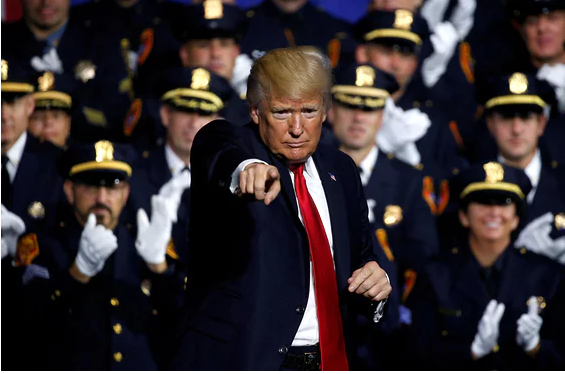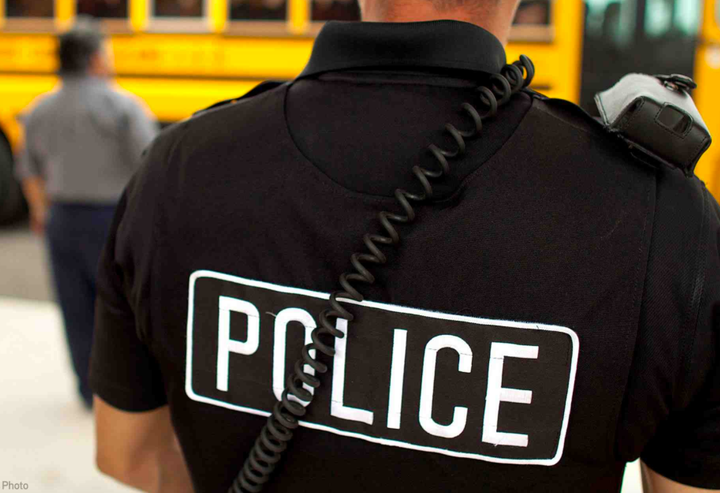
At Brentwood, NY, President Trump called for more police intervention in schools.
“Bullies in Blue,” an ACLU white paper written by Megan French-Marcelin, argues that stationing police officers in schools has effectively criminalized teenage pranks, especially for minority youth, and fed the school-to-prison pipeline. This is an especially timely piece because recent events in the Bronx, in New York City, have led to calls for an increased police presence in schools.
As many as 20,000 police personnel are already stationed in U.S. schools and President Trump’s anti-immigrant and anti-gang initiatives may pour thousands more into school buildings searching for undocumented immigrant youth. In suburban Suffolk County, part of the greater New York City metropolitan area, after school officials shared disciplinary records with police, innocent high school students were swept up in a police anti-gang action applauded by the President.
In the 2013-14 school year, schools referred over 223,000 incidents to law enforcement officials. Teenagers are arrested and charged with felonies for pranks like releasing “fart spray” in class. A Texas teen was charged with forgery when a $2 bill he used to pay for lunch was fake. A middle school student in Virginia was charged with assault and battery for throwing a baby carrot at her teacher.
The ACLU study charges that assigning police to manage student behavior in schools was “driven by the same punitive criminal justice policies and assumptions that drove the overcriminalization of Black and Latino communities and spawned an era of mass incarceration.” In many parts of the country the move to put cops in the classroom was a direct response to the African American civil rights movement’s push to desegregate the South. “By the 1970s, police regularly patrolled newly integrating or majority Black and Latino schools in 40 states, looking for behaviors deemed disruptive under the justification that it would prevent the outbreak of larger crime.” Advocates for the “broken windows” theory that justified police occupation of minority schools and communities specifically wanted to target what they described as “rowdy youth.”
Placing police in classrooms expanded in the 1990s, sometimes in response to crimes, but more often out of fear of teenage Black and Latino youth deemed “superpredators.” During the Clinton and Bush administrations, federal tax dollars poured into school districts, but instead of funding education, they were directed toward policing.

According to “Bullies in Blue” policing policies in schools criminalize normal teenage behavior.
The ACLU reports that school arrests disproportionately affect students of color, especially students with emotional disabilities more likely to act out. “Nationally, Black students are more than twice as likely as their white classmates to be referred to law enforcement.” In one state, South Carolina, “Black students are almost four times as likely as their white counterparts to be charged with ‘disturbing schools’ — an unconstitutionally vague and broadly worded law that allows police to arrest students for any behavior deemed ‘disruptive’ or ‘obnoxious.’”
A major ACLU concern is the violation of fundamental student rights. The report finds that police in classrooms “often become involved in noncriminal matters, jeopardizing students’ rights to be free of unwarranted ‘search and seizure’ in violation of the Fourth Amendment.” Privacy rights are further undermined when police conduct surveillance on students, search student records, and share information with other branches of law enforcement.
According to Dennis Parker, director of the ACLU’s Racial Justice Program. “The atmosphere of fear and mistrust experienced by many people of color on the streets as a result of abusive and unwarranted stops and arrests has even greater consequences when it occurs in schools, which are supposed to be safe spaces conducive to learning, not places to prepare young people for a place in the criminal justice system and correctional institutions.” Children are body slammed, tasered, pepper sprayed, choked, and placed in handcuffs. In one documented incident in Virginia, a four-year-old boy with attention deficit disorder was handcuffed for throwing a temper tantrum in class. In another case, a 16-year-old boy in Pasadena, Texas was arrested and struck eighteen times with a metal nightstick, with the blows continuing after he had fallen to the ground.
South Carolina and seven other states have what they call a “Disturbing Schools Law.” Under the South Carolina statute, it is a misdemeanor “For any person willfully or unnecessarily . . . to interfere with or to disturb in any way or in any place the students or teachers of any school or college in this State” or to “act in an obnoxious manner.” Willful meaning on purpose; unnecessarily means a student can violate the law, even when the disruption is not willful. The penalty for these “crimes” is a “fine of not more than one thousand dollars or be imprisoned in the county jail for not more than ninety days.”
Under the wording of this law, every middle school boy I know is a felon; “obnoxious” defines a middle school boy’s behavior. If I had to spend an additional 90 days in jail every time I shouted out an answer in class or willfully didn’t do homework, or unnecessarily blew my nose too loudly, I would still be in jail today, sixty years later. In fact, I think the jails would be overflowing with boys of all ages who got caught picking their noses, knocking books off shelves, pushing each other in the halls and copying homework, and with the girls who disturbed school functioning by letting us copy their homework.
The ACLU study offers eight specific recommendations.
- End the routine policing of schools.
- Provide equal educational opportunities and positive school climate for all students in all schools.
- End the practice of arrests and referral to law enforcement for common adolescent behaviors.
- Hold police to the same standards in schools as applied elsewhere in our communities.
- Invest in supportive resources.
- Enact policies that create specific protocols for when and how police should interact with students in schools.
- Police should reform policies and training for responding to youth, including, but not limited to when responding at schools.
- Collect, review, and provide the public with quality data on police activity in schools.
Based on research, the ACLU concludes that police in schools do not make schools safer. That is the job of trained and caring educators. It calls for counselors, not cops, in schools.
Follow Alan Singer on Twitter: https://twitter.com/ReecesPieces8
